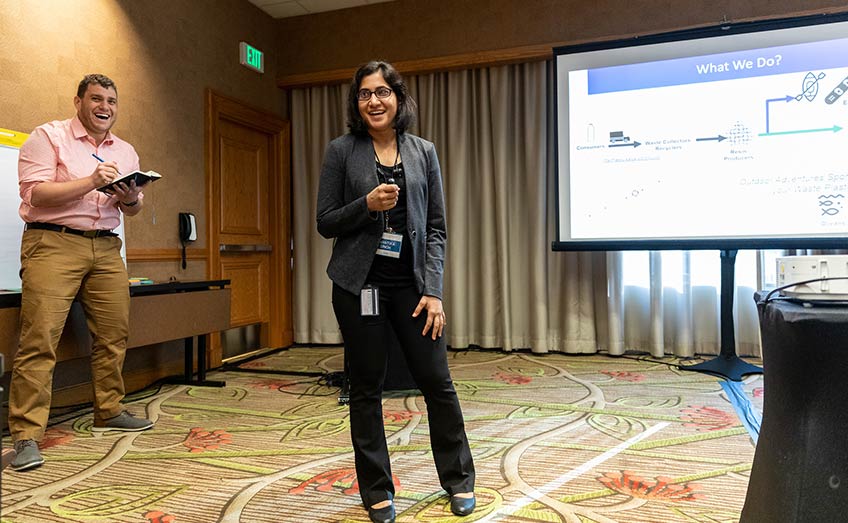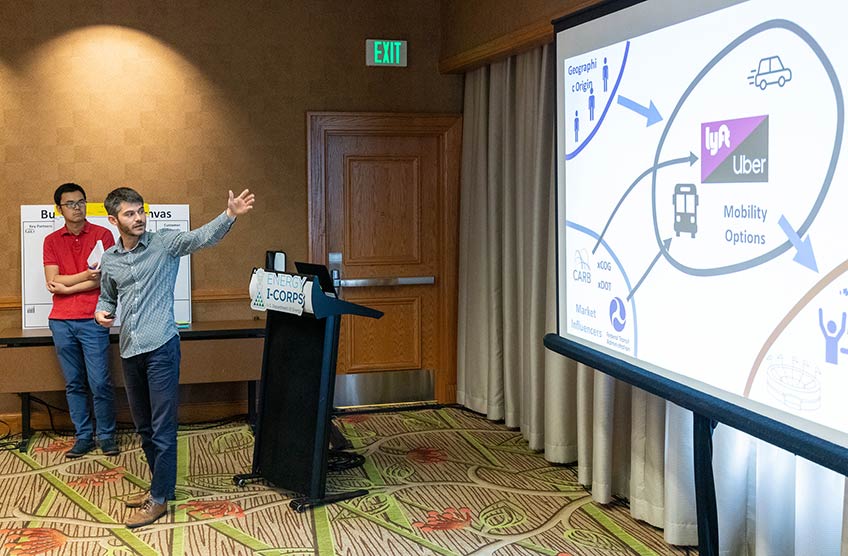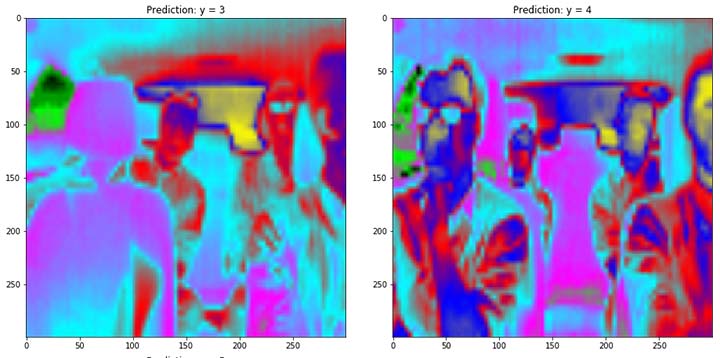NREL and Energy I-Corps Produce Eco-Plastics, Transportation Tech-to-Market Hopefuls

Energy I-Corps, the U.S. Department of Energy’s “boot camp” for national laboratory-based startups, has selected two teams from the National Renewable Energy Laboratory (NREL) for its fall cohort.
Ten research teams from the national laboratory system made the cut, including NREL’s Cycle and HeadCount teams:
- Cycle is addressing plastic waste by upcycling polyethylene terephthalate (PET) and combining it with biomass-based polymers.
- HeadCount is filling a transportation information gap by counting how many people take each Uber or Lyft ride.
The two teams started Energy I-Corps in October and are progressing through a two-month curriculum that requires investigation into the industry they hope to impact.
“People love to complain about PET because of what it’s doing to the ocean,” said Nic Rorrer, NREL polymer chemist and technical lead for the Cycle team. “But it’s a fantastic material. It has great strength, great permeability, you can shape it in different ways…there’s a cool marriage between advantaged bioproducts and plastics recycling.”
The recycling rate for PET is currently only 28.4 percent, and much of the rest ends up swirling around giant garbage patches in the ocean. The Cycle team aims to disrupt that pollution flow by finding new uses for PET–in particular, upcycling the plastic after breaking it down with an enzyme called PETase.
As I-Corps projects go, Cycle is going big by looking at the whole value chain of PET recycling and reuse. They expect their initial market for the product to be outdoor gear, a specialty consumer area with high profit margins that seems always open to new products.
Rorrer’s partner at NREL is Avantika Singh, a chemical engineer who was doing techno-economic analyses on biomass for two years before returning to plastics (the focus of her master’s degree program) for this project. Singh said that she finds the nuts and bolts of I-Corps “fascinating,” partially because it zooms into the realities behind techno-economic analysis models.
“In techno-economic analysis, we look at the transition from bench-scale to full-grown industrial production,” she said. “What’s new here is seeing the intermediate milestones.”
During their first week in I-Corps, the instructors were already complimenting the team on their understanding of the PET recycling market as it currently stands.
HeadCount: Tallying Warm Bodies to Reduce Car Trips
Between air pollution, traffic congestion, and longer commute times, transportation planners have plenty of problems to tackle. But without adequate data, they cannot effectively plan for growth in their cities or regions.
Transportation data on rides, vehicles, and routes is already being packaged, sold, and studied. However, NREL researchers Yi Hou and Matt Moniot discovered a critical gap in that data: how many people actually take each Uber or Lyft ride. If each shared ride is transporting two people instead of one, that massively affects how much gas that transportation mode uses.

Yi Hou and Matt Moniot of NREL's HeadCount team explain the transportation industry ecosystem map they developed. Photo by Werner Slocum/NREL
On nights and weekends, HeadCount team members Hou and Moniot set out to collect the missing data by developing a sensor that could stick to a dashboard, not get in the way of the driver, and count heads (hence the name).
It was tricky–the sensor needed to count people without violating riders’ privacy, and they needed to write computer code that could do it automatically (without needing a person to sift through thousands of images).

After a few iterations, they hit on an infrared sensor that could total ridership based on heat signatures. They built a prototype, Moniot said, but they are still investigating whether there is a market for their product in advance of potential regulatory changes.
Moniot joined I-Corps partially because of his desk location: right between two researchers, Jake Holden and Clement Raines, who’d gone through I-Corps the previous year with a connected-transportation idea of their own. Hearing the two go back and forth on their ideas, Moniot realized that I-Corps offers a lot.
“Even if you don’t come out of it with a startup or a business plan, the lessons learned seemed very important,” Moniot said. “I want to see lab-developed technology out into the world.”
Hou, who used to work for General Electric looking for faults in jet engines, collaborated with Moniot on a software-hardware combination. They’d validate their imaging equipment in NREL co-workers’ cars when they went to lunch.
Like many others in the program, Hou said the most enlightening part about I-Corps so far has been the huge variety of customer interviews in the discovery process—a minimum of 75 for each team. “You need to ask. And you need to ask the right questions,” he said. “We’ll pivot based on what they say.”
Applications for the next round of research teams are now open and due by Nov. 15, 2019.
Last Updated May 28, 2025
